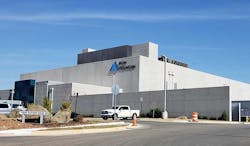Renewable Energy and Rising Energy Costs: Market Dynamics at Play
Energy costs are rising around the world and that’s affecting everyone. The data center industry is a major consumer of energy and is therefore greatly impacted by the market price of power.
Across the industry, markets around the world are feeling the impact from the ongoing war and resulting constraints in the supply of fossil fuels. In some locations energy prices have doubled, or more, and the rising prices can lead to some confusion among data center customers. How can an industry at the forefront of renewable energy be so impacted by rising fossil fuel prices?
That’s a very good question. At Iron Mountain Data Centers, we have been committed to renewable power since 2017, and yet we still are affected by the current market. It is therefore important to understand the market dynamics at play.
Energy market drivers
The short answer is that the cost of electricity, whether renewable or carbon intensive, is still strongly tied to the cost of fossil fuels. Specifically, the cost of natural gas as it remains the primary generation fuel for supplying power to the grid for many communities around the world.
When there is a constrained supply of natural gas, with no change in market demand (or worse, an increased demand due to extreme hot or cold weather), the price of natural gas goes up. That has been occurring across Europe as gas flows from Russia, Europe’s largest supplier of natural gas, reduced sharply.
Countries do have strategic reserves of stored gas which can help stabilize local market prices, but these storage amounts are very small compared to their annual demand and therefore provide only short-term benefits, needing to be replenished regularly. The opposite also happens, by the way. When gas supply is strong and storage levels are high the cost of natural gas remains lower and therefore electricity is cheaper.
Today’s constrained natural gas volume is commanding historically record high prices. And when people look ahead to see that available supply might struggle to meet future demand it puts a further, added premium on already high natural gas prices.
In fact, it can be even worse for renewable energy procurement today. Not only are renewable power options impacted by the rising cost of fossil fuels, but clean energy is viewed as a preferred, premium product. So, it often costs more than fossil-based energy because there’s a green premium on it.
How is renewable energy tied to fossil fuels?
It’s true that generation from clean energy projects like wind and solar is the lowest cost generation available. And, as it doesn’t rely on the cost or availability of fossil fuels to produce energy, it is a clear path forward towards a resilient, lower cost energy future. In fact, renewable energy sources are already helping to reduce the cost of power on the grid today, though it may not be readily apparent.
Unfortunately, we’re still a long way away from carbon free energy being available to meet all our needs each hour of the day, and this ongoing reliance for on demand, or ‘dispatchable’, power that is met today by fossil-based generation is coming at a significant price.
Let’s dig a little deeper into how natural gas prices drive the price paid for renewable energy.
Electricity grids commonly operate what is known as an Economic Dispatch model wherein generators bid in to meet the forecasted demand requested by the grid operator. Bids are awarded on merit order, based on the price bid into the system, with lowest prices selected first.
This is where operators of carbon free assets have a clear advantage – they can bid in a much lower price than the operator of a natural gas plant in a gas-constrained market. However, as the grid must accept bids to match its entire forecasted load, and therefore deliver the reliability we all expect, they continue accepting bids in merit order for a given hour until their entire load is satisfied.
The price paid for the final accepted bid becomes the established price of power paid to all generators, regardless of their accepted offer or generation costs. In this model, the benefits of carbon free energy is limited by the carbon-intensive generation it is able to displace. For hours met primarily, or perhaps entirely, from carbon free resources bidding in at lower costs the overall cost of power will be lower.
Doing this each hour of the day from clean energy sources like wind and solar, which are intermittent, is the challenge we’re taking on with our 24/7 Carbon Free Energy goal.
So, it is our dependence on a stable, reliable power supply that cannot be fully met today by intermittent carbon free resources that leaves us dependent on fossil fuels and coupled to their volatile market prices.
We’re making progress though. When it comes to adding new generation to the grid, carbon free sources are greatly exceeding new fossil-based assets. The grid is indeed getting greener, and storage is being added which will help optimize generation from intermittent wind and solar resources.
Energy procurement strategies also play an important role
One of the ways we and others in the industry navigate volatility in the energy market is to purchase power in advance at fixed prices. It is an investment of time and effort to strategically buy power in advance, helping to control future costs for our clients.
We do this with the support of advisors, and with energy procurement so vital to a data center it is well worth the investment to deeply understand the market. Our customers depend on us to help insulate them from the day-to-day market volatility, like what we see in Europe today.
As a result, what people may see in the news regarding all-time high costs of power may or may not be reflected in what they pay at their data center because of how the data center buys power in advance.
In one of our markets, for example, the price we secured for our customers is less than half of the current market price of power because we purchased it 18 months in advance. Yes, their cost has gone up from what it has been in the past, but it’s currently lower than the market price today.
While securing power far in advance may sound like it solves the problem of price volatility, there is a hidden challenge within this. If a contract comes up for renewal at a time of extreme market prices, as we see today, costs can move up suddenly as we take on the next multi-year position.
Nobody knows with certainty what pricing will be a year or two from now and that makes it very tricky to navigate. We generally build a portfolio of positions rather than single contracts to diversify our risk.
How carbon free energy can be the solution for long term, lower costs of energy
I explained earlier how carbon free energy is still commanding the same price as fossil fuel based power, or higher, despite being lower cost to generate. Each generation asset powering the grid receives more or less the same price for what they produce. Until most or all of the power supplying the grid is carbon free, we will all pay prices impacted by the market cost of fossil fuels. Even those of us purchasing enough renewable energy to offset our annual consumption from the grid because we need consistent energy.
There is one notable exception for large energy consumers supporting clean energy, and that is to get engaged on wind, solar or other carbon free projects early in their development process, well before they are constructed. These projects require significant capital and raising these funds is difficult when the project’s future revenue stream from selling power into the grid is uncertain.
Nobody knows the cost of power tomorrow, let alone 20 years from now. Corporate energy buyers, like Iron Mountain Data Centers, are stepping in to assure a fixed price to the developer which enables a known return on capital for investors. These opportunities require long term commitments of ten years or more, and the contracts can be complex. In return, the corporate offtaker can effectively hedge their energy costs for a very long time, based on the lower cost of clean energy generation that is decoupled from the fossil fuel market.
This is an important element in the portfolio of procurement solutions used by our industry, and we need more of it. Matching each hour of our demand from new, local, carbon free resources is the path to long term, lower cost, decarbonized energy supply.
Looking Ahead
We all recognize that we need more carbon free energy to help combat climate change and create a sustainable planet. And, despite the cost of renewable power climbing in sync with the fossil fuel market, we are indeed making collective progress.
While carbon free energy is in fact reducing energy costs today, we simply don’t have enough of it supplying our hourly needs to make a consistent, recognizable impact. We must stay the course, though, and in time the results of today’s investments will become clear. There is tremendous commitment at the national level to create policies that facilitate accelerating clean energy and enable more wind and solar projects to be built.
The current energy crisis is certainly manifesting into demonstrated commitments to carbon free energy resources and is accelerating the development of those projects.
I believe we will get to a turning point where most of the power on the grid comes from carbon free resources, and the energy paradigm will change forever.
It’s a day we can all look forward to.
Chris Pennington is the Director of Energy and Sustainability at Iron Mountain Data Centers. Chris has been with Iron Mountain for 30 years in various roles and was instrumental in developing their industry leading energy program. Contact Iron Mountain to learn more about their data center solutions.




